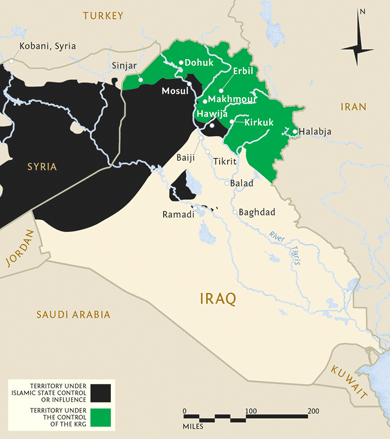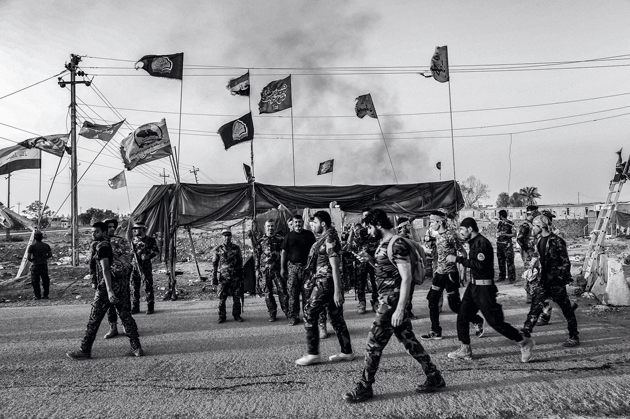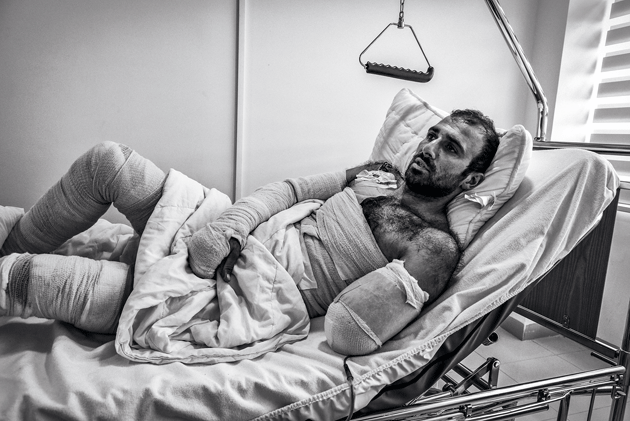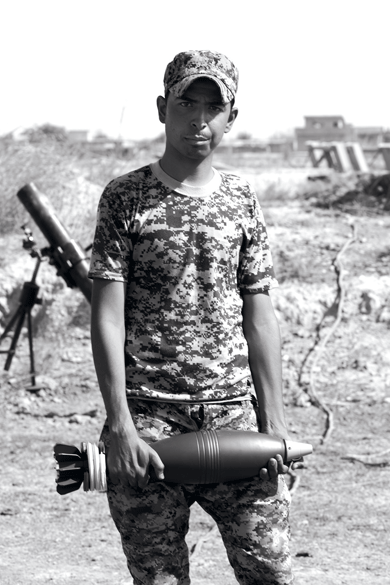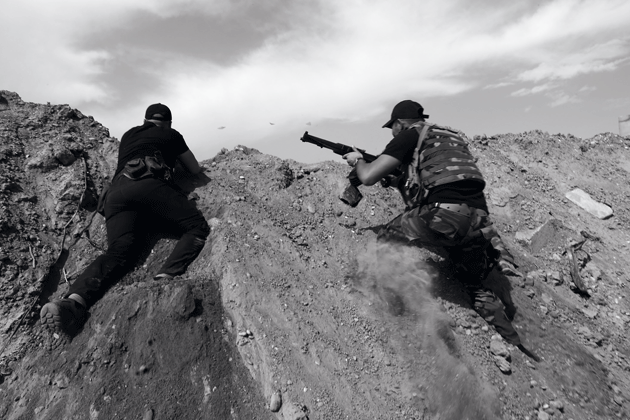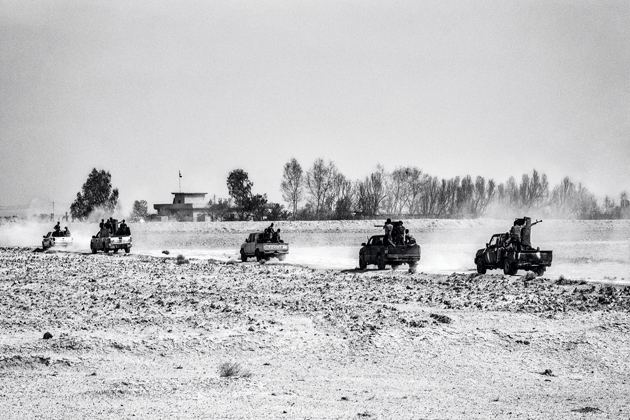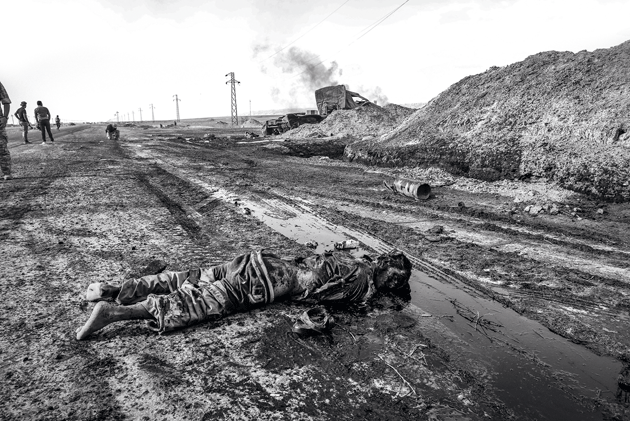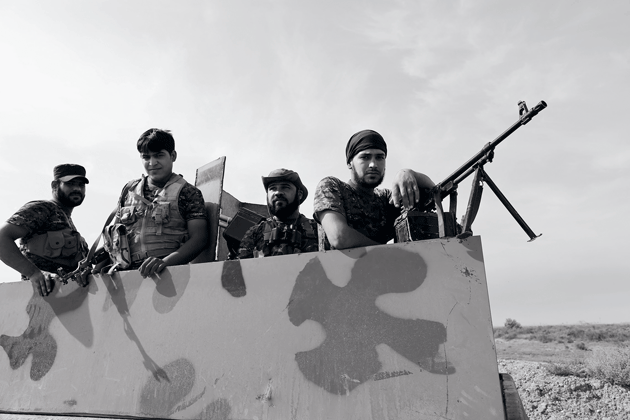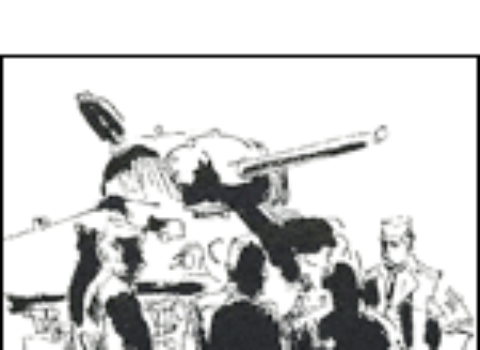For two months in the summer of 1962, Dana Adams Schmidt, a correspondent for the New York Times, vanished into the wilds of Iraqi Kurdistan. He called the book he eventually produced about the experience Journey Among Brave Men. The Kurds were and are among the most courageous fighters in the world. Their many rebellions, insurrections, and uprisings over the centuries have begun with small victories and ended in cataclysmic defeats. Reliable allies have eluded them, while their aspiration to govern themselves has alienated the countries they inhabit, including Turkey, Iran, Iraq, and Syria. “Among governments in the area,” Schmidt wrote of his Kurdish hosts a half-century ago, “they have not a single friend.” To this day the Kurds claim, as one of their proverbs puts it, “no friends but the mountains.”
Kurdish leaders nonetheless retain an almost mystical trust in the United States, despite a history of American betrayals. Henry Kissinger sold them out to Saddam Hussein in 1975. George H. W. Bush called on them to revolt in 1991 and then allowed Saddam to deploy his air force against them. Today, Kurds from northern Iraq, Syria, and Turkey, as well as a band of about 500 fighters from Iran, make up the most capable ground forces in Iraq, where they have been confronting the Sunni fanatics who call themselves the Islamic State. Still, support from the United States has been slow to arrive. The Kurds have clawed back most of the territory that the Islamic State seized from them in 2014, but a dearth of supplies, weapons, funding, and logistical aid has driven the Kurdish death toll for that campaign needlessly high.

A peshmerga fighter on the northern front, Kirkuk. All photographs © Don McCullin/Contact Press Images
Last fall, the photographer Don McCullin and I toured the Kurdish and Arab Shiite front lines that faced Islamic State territory. In the north, the Kurds were digging in rather than moving forward. In the south, however, the Iranian-funded Shiite militias known as the Hashd al-Shaabi were advancing in long columns, with zealous young volunteers waving flags from open pickup trucks. “Most of the volunteers were fighters against the U.S. when it was here,” Mohanid al-Ikabi admitted. Ikabi, a tall and outspoken man in his mid-thirties, is the director of propaganda for the Hashd al-Shaabi. He explained that after U.S. forces withdrew from Iraq in 2011, Shiite militia members returned to civilian life. Then came the summer of 2014, when the Islamic State seized nearly a third of the country. The Iraqi Army collapsed. Baghdad was on the verge of falling when Ayatollah Ali al-Sistani released a fatwa that called for the Shia to defend themselves against the Sunni fighters. The militias returned to the battlefield. “They felt it was the same as the U.S.,” Ikabi said, “that I.S. was the U.S.”
McCullin photographed the Hashd al-Shaabi as they captured an oil refinery at Baiji, 240 kilometers north of Baghdad, more than halfway up the road to Mosul, which the Islamic State has held since June 2014. The Shia are less reliant on American air power than the Kurds are. Thanks to both Baghdad and Iran, they have better arms: heavy artillery, antitank missiles, and large ammunition stores. After Baiji, however, the Shiite volunteers postponed their long-awaited assault on Islamic State forces in Ramadi, the capital of Anbar province. The Hashd al-Shaabi may have had the weapons, but they were undisciplined and seemed better at hit-and-run attacks than sustained infantry assaults.
Since the Syrian war erupted in 2011, alliances have crumbled and borders have disappeared. The United States is battling the Islamic State with drones and bombers in the air and special forces on the ground. Until recently, however, it has handicapped its own campaign by shunning the group’s most successful opponents. In Syria, they are Russia, the Syrian army, Iran, and Hezbollah. In Iraq, it is Iran again. The United States keeps the Kurds at arm’s length in deference to Turkey’s anti-Kurdish sentiments and Baghdad’s fear of a strong Kurdish armed force that might seize territory beyond the present borders of the Kurdistan Regional Government (K.R.G.). Meanwhile, America’s regional allies — Turkey, Saudi Arabia, and Qatar — are enablers of the Islamic State and other Al Qaeda offshoots, such as Jabhat al-Nusra and Ahrar al-Sham. It’s a mad, mad, mad, mad war, and it ain’t over by a long shot.
America’s refusal to coordinate with the Islamic State’s disparate enemies has prolonged the conflict and cost Syrian and Iraqi civilian lives. It has also left the group free to plot the murder of civilians on Russian airliners, in Beirut’s southern suburbs, at pro-Kurdish peace demonstrations in Turkey, and at public venues in Paris. The Islamic State benefits from America’s failure to compel Turkey to close its borders to the flow of jihadis, weapons, and funds. Its fighters have free passage in and out for operations against Europe, Russia, and, possibly, the United States. American policy is at best schizophrenic, at worst criminal.
The peshmerga, “those who face death,” are the traditional fighting force of Iraq’s Kurds. They have been divided since 1975 into factions loyal to two rival political parties, the Kurdistan Democratic Party (K.D.P.) and the Patriotic Union of Kurdistan (P.U.K.). The K.D.P. and the P.U.K. fought a civil war that ravaged the country from 1994 to 1997. Nonetheless, they are united under the Ministry of Peshmerga Affairs, which is headquartered in a barricaded old building near the center of Erbil, the Kurdish capital. The head of the ministry, Mustafa Sayyid Qadir, belongs to neither the K.D.P. nor the P.U.K. and thus enjoys the loyalty of both. Four days before we met him, last October, the Kurds had shortened their jagged front from 1,050 kilometers to 750 by capturing eleven villages south of Kirkuk. Qadir insisted that the Kurds were fighting the Islamic State without assistance from Baghdad.
A wall map delineated eight sectors, four each for the K.D.P. and the P.U.K., along a front that stretched from the Syrian to the Iranian border. Qadir said that the line would remain static for the time being. But Kurdistan would not be secure until the Kurds or the Iraqi state controlled Mosul. The city was too important to ignore: it dominates the region west of Erbil, as well as the Kurds’ main highway to Syria. “From our front to the center of Mosul is seventeen kilometers,” Qadir said.
With American assistance, the Kurds liberated Mosul from Saddam Hussein’s army in 2003. The city fell to Sunni Arab jihadis a year later and endured years of chaos until 2014, when it was captured by the Islamic State. The peshmerga, bereft of resources and navigating complex ethnic politics, now refuse to conquer Mosul on their own. Only a small portion of the city, on the eastern bank of the River Tigris, is Kurdish, and the Arab majority on the western side would resist Kurdish and Shiite invaders. Retaking the city requires a national Iraqi Army that barely exists.
Most Kurds are Sunni Muslims; a minority, the Faili, are almost all Shia. The Turkmen, Iraq’s third-largest ethnic group after the Arabs and the Kurds, are divided between Sunni and Shia. In some places Sunni Turkmen side with the Kurds, while others prefer the Islamic State. Many Shiite Turkmen resent living under the K.R.G. and have volunteered for the Hashd al-Shaabi. The Yazidis, who practice a religion related to Zoroastrianism, were disappointed by the Kurds’ failure to protect them from genocide and mass rape at the hands of the Islamic State and have formed their own militias. Some Christians, themselves divided into various Orthodox and Catholic sects, have joined the peshmerga, while others have formed self-defense units to protect their villages. Iraq’s Sunni Arabs resent encroachment by the Kurdish Sunnis and the Arab Shia, although many have taken refuge from the war in the comparative safety of Iraqi Kurdistan. Some have gone over to the Islamic State, while others stand by their tribal chiefs, the government in Baghdad, or the Kurds. The sectarian hatreds unleashed by the American invasion of 2003 have intensified, and the war against the Islamic State, which should have united the country, is dividing it further.
Outside the oil city of Kirkuk, which the Kurds liberated in 2003 and took again in 2014 when the Iraqi Army abandoned it, an isolated villa stands in a leafy eucalyptus grove. This is the headquarters of Sheikh Jaafar Sheikh Mustafa, the commander of the peshmerga’s 70th Brigade and of the P.U.K.’s four frontline sectors. Sheikh Jaafar, like so many of the military leaders McCullin and I met in Kurdistan during the wars of 1991 and 2003, had been a peshmerga since his teens. He joined the rebellion of Mullah Mustafa Barzani, the father of modern Iraqi Kurdish nationalism, against the Baathist regime in Baghdad in 1969. Sheikh Jaafar and his comrades fled to mountain caves with the remnants of the rebellion when Saddam Hussein crushed the uprising in 1975. He served as minister of peshmerga from 2006 to 2014, but he seemed more at home on the front than in an office.
“The majority of our casualties are from I.E.D.’s,” he said. “We have to pick up I.E.D.’s with our hands and dismantle them.” The Islamic State has left behind thousands of booby traps to kill or maim the attackers who drove them out. If the Kurds had modern bomb-disposal equipment, they would lose fewer lives. (Qadir, the current peshmerga minister, had told us that I.E.D.’s accounted for 90 percent of Kurdish casualties.)
At the Swedish Specialist Hospital, in Erbil’s largely Christian Ankawa quarter, we had met a thirty-one-year-old peshmerga named Halo Ramishtee, from northwestern Iran. Clean white bandages were wrapped around most of his torso and his legs, covering the wounds caused by shrapnel. He told us that he was a bomb-disposal expert who had trained with the Americans and held an international certificate of mine disposal. When the peshmerga took a village called Ghubaiba, southwest of Kirkuk, from the Islamic State, Ramishtee and his team went in to clear the explosives that were left behind.
“I had finished defusing the first one, and I stepped forward,” he said. “I triggered a trip wire that set off an I.E.D.” That cost him his left arm, which was severed at the elbow. “If I had special clothes, I would not have lost my arm.” Before coming to Iraq, Ramishtee had fought with the Kurdistan Freedom Party of Iran against the government in Tehran. “I want you as an American to know me as a Kurd, not as an Iranian,” he said. He was lying calmly on his bed with a tube near the stump of his upper arm that drained blood into a clear sack. “I came to defend my flag. Still I can give both my legs and my other hand to make my nation free.” For him, as for many Kurds, the goal is independence for all of Kurdistan, not just the portion in Iraq.
In Kirkuk, Sheikh Jaafar’s assistant, a young man named Akam, told us that Islamic State fighters came close to the headquarters building at night. “We don’t see them. We have no night-vision equipment.” Sheikh Jaafar recited a shopping list that would test the quartermaster corps of any army: uniforms, boots, mortars, heavy artillery, rockets, transport vehicles, surveillance drones, helicopters. “I’ll be honest with you. We need everything,” he said. “We need something to balance with I.S., because it is much stronger than we are.” The Islamic State has modern tanks, artillery, rockets, night-vision goggles, troop transports, and antitank rockets that it captured from the Iraqi Army, in addition to the weapons it imports through Turkey.
McCullin and I left Sheikh Jaafar’s villa and visited the front line, a few minutes away. Here, the peshmerga were constructing miles of earth and cinder-block fortifications to a height of about twenty feet. In front of the barricades were trenches, barbed wire, and land mines. General Rasheed Ali, the deputy commander of the post, climbed with us to the parapet and said with pride, “We built these hills.” Below us lay a field of fire, flatland interrupted by a few bare trees and the rubble of two villages, across which the peshmerga could, at least in daylight, spot advancing fighters from a good five miles away. Ali told us that the villages were Tal Wared and Sayed Khalat, which the peshmerga had captured. “I.S. was confused and ran,” he said. “When we did the operation, we asked for ammunition for two thousand soldiers. But they sent us one thousand bullets.” Worse, he said, he received shells that did not fit his 81mm mortars.
One of the Islamic State’s most effective tactics has been to breach defenses with suicide drivers in armored trucks filled with explosives. When Ali’s men entered the villages, they captured three such trucks. “Each one had a ton of explosives that were ready to be used against the peshmerga,” he said. Small arms and rocket-propelled grenades cannot stop the trucks. The only antiarmor missiles in the Kurdish arsenal are an estimated sixty MILAN rocket launchers supplied by Germany, one for every twelve kilometers of the 750-kilometer front. Fortunately for Ali and his men, the Islamic State did not have time to use the trucks.
The general admitted that his forces bulldozed the villages before they withdrew. While it may have made military sense to deprive the Islamic State of cover, the destruction provoked accusations that the Kurds were ethnically cleansing the area of Sunni Arabs. The Kurds have long resented the presence of Arabs who were resettled in the north by Saddam Hussein during his Arabization program of the Seventies and Eighties. Despite their denials, the peshmerga may have seized a chance to remove an ethnic obstacle to Kurdish control of the region in the future. After bulldozing Tal Wared and Sayed Khalat, the Kurds drew back about a mile and established the massive barrier from which we surveyed the battlefield.
“For right now, there is no plan,” Ali told us. Hawija, the largest town held by the Islamic State south of his post, is the capital of a district with a peacetime population of about 400,000, almost all of them Arab and Sunni. To take the town, Ali said, the Kurds would need to coordinate with the Iraqi Army. He sighed. “That means it’s not going to happen.”
As McCullin and I left the frontline post, young Kurdish fighters carrying their bedding and food arrived on foot to replace the men who were rotating back to civilian life after two months on duty. Their faces were full of the optimism reserved for those who have yet to see combat. Because of budget shortages stemming from a dispute with the central government in Baghdad, as well as low prices for Kurdish oil exports, the K.R.G. had not paid the peshmerga, its teachers, or its civil servants since July. Yet these youngsters were showing up at the front, unpaid and underequipped. But for how long?
I was born in a cave in 1968,” said Nemam Ghafouri, a cardiothoracic surgeon who has practiced medicine on five continents. Her father was a peshmerga in Mustafa Barzani’s rebellion, when Kurdish fighters and their families took shelter in caves to escape Iraq’s air force. In 1974, Ghafouri’s family took her to Iran. She studied medicine in Sweden, where she still has a home. Last year, she returned to Kurdistan to work with a medical charity in Dohuk, a Kurdish provincial capital in the hills north of Mosul, close to the Syrian and Turkish borders with Iraq. She treated Kurdish refugees from the Syrian village of Kobani and Yazidis from the Iraqi town of Sinjar. During her work in Sinjar, she noticed that the peshmerga had no medical corps. She raised funds, found a truck, and used it as a mobile clinic.
“We were the only medical team on Sinjar Mountain,” she said. She was frustrated with the U.S. response to the crisis: “The peshmerga called in the exact positions of the Islamic State. The American planes flew over and did nothing.” She believes that Barack Obama should return his Nobel Peace Prize and blamed Turkey for hindering the Kurds’ campaign against the Islamic State by bombing members of the Turkish Kurdish Workers’ Party who were fighting in Iraq. “The Islamic State has an air force,” she said, “provided by Turkey.”
In Kirkuk, Najmaldin Karim, the provincial governor, complained that the Kurds needed more than a medical corps. “The peshmerga don’t even have boots,” he told us. “The young peshmerga are very brave. They don’t get paid.” Kirkuk is divided into ethnic and sectarian camps and is claimed by the Kurdish and Iraqi governments. It is a so-called disputed territory, on the frontier between Iraq’s Arab and Kurdish zones. When the Iraqi Army units based in Kirkuk fled from the Islamic State in 2014, however, the Kurds were the only forces that were able to defend the city, its oil fields, and the surrounding villages. They are unlikely to relinquish them. Many Kurds insist that Kirkuk should become their country’s capital when they achieve independence, even though only half of the city’s population is Kurdish. The Arabs, Turkmen, and Christians who make up the rest are not likely to welcome Kurdish rule.
As a young man, Karim was the personal physician to Mustafa Barzani. He subsequently became a neurosurgeon in Washington, D.C., and a U.S. citizen. When James Brady, Ronald Reagan’s press secretary, was shot in March 1981, Karim was among the doctors who treated his wounds. He returned to Kurdistan in 2009. Voters in his native Kirkuk elected him to the Iraqi Parliament the following year. In 2011, Kirkuk’s provincial council appointed him governor. For the Kurds, control of Kirkuk is the greatest prize in their war against the Islamic State. Yet Karim saw no reason to celebrate. “How can you be optimistic when things are going from bad to worse?” he asked.
Karim’s office was protected by blast walls, security checks, and bodyguards. He told us that the longer the Islamic State occupied the region south of his city, the harder it would be to remove. Why? “Ninety percent of the people who support them are local people,” he said. “They recruited a lot of young people. Some don’t listen to their families. Even some Kurds have joined them.” As jihadis from the Islamic State put down roots in Iraqi communities, they have been able to attract more local recruits for operations in the Middle East and in the West.
Karim has ordered the digging of deep trenches around Kirkuk to deter Islamic State suicide bombers. “The U.S. is cooperating with air strikes,” he said, “but they do not give [the peshmerga] weapons.” This means that the Kurdish forces are not independent, because their ill-equipped troops cannot attack the entrenched positions of the Islamic State without air cover from the Americans or another ally.
As long as the Islamic State holds on to portions of Syria, Karim said, the group will be a threat to Iraq. Thus, its enemies must defeat the Islamic State in both countries. Karim believes, as many do, that the task would be easier if Turkey closed its borders to the jihadis: “If they control that border, the Islamic State will have no access.”
McCullin and I visited another sector of the front line, at Makhmour, about two hours south of Erbil. The commander there was a civilian named Nejat Ali, who received us under a shaded porch outside his headquarters. He and a dozen or so of his men drank tea and coffee within sight of a row of Humvees in the parking lot. The Humvees were not given to him by the United States, he said. The Kurds captured them from the Islamic State, which had taken them from Iraqi soldiers who had abandoned their posts. Makhmour, like Kirkuk, is a disputed territory that the Kurds recently conquered.
Ali remembered the battle to take the town, which the Islamic State had held for only three days. “We attacked I.S. and liberated Makhmour in two hours. They left I.S. bodies and weapons like mortars, Dushkas [Russian heavy machine guns], and Humvees.” His peshmerga pushed the line back another seventeen kilometers and stopped. Most of the estimated 100,000 civilians who lived in Makhmour and nearby villages before the war had taken refuge in Erbil during the battle. About a hundred Arab families went south with the Islamic State, Ali said. He did not intend to allow their return.
His complaint was the same one we had heard all along the line: “We have enough men, but we don’t have enough weapons. We did not receive anything except two MILANs from Germany.” His post had more armaments, however, than the others we had seen. “All this,” he said, pointing to the row of Humvees, “we captured from I.S. Those Humvees are Iraqi. Now we use them against I.S.”
The policies of the Iraqi government seemed to him self-defeating: “Iraq is dealing with Sunni Arabs as if they were the enemy. It treats Kurds like the enemy.” The Russian intervention in Syria gave him some hope. “Russia could liberate Mosul and Tikrit, but that could be bad for us. Until now we believe we are allies of America.” Like the other Kurdish commanders, however, he felt that his ally was letting him down. “As Nejat, not as a commander,” he said, “I don’t care who is supporting the peshmerga, Russia or America.”
During the rebellion of March 1991, McCullin and I accompanied Massoud Barzani, the son of Mustafa and the current president of the K.R.G., as his forces liberated Iraqi Kurdistan and surrounded the Iraqi garrison in Kirkuk. At the same time, the Shia in the south were rising up against Baghdad. The rebels eventually seized fourteen of Iraq’s eighteen provinces. It was an exciting moment that seemed likely to foreshadow the end of Saddam Hussein’s reign of terror. Shortly after signing a ceasefire agreement with the United States and its allies, however, Saddam sent his air force back to Kurdistan. McCullin and I watched Kurds flee as the regime’s helicopters dropped barrel bombs on their villages. The great fear was that the barrels contained the same chemicals that Saddam had used to asphyxiate the Kurds of Halabja in 1988.
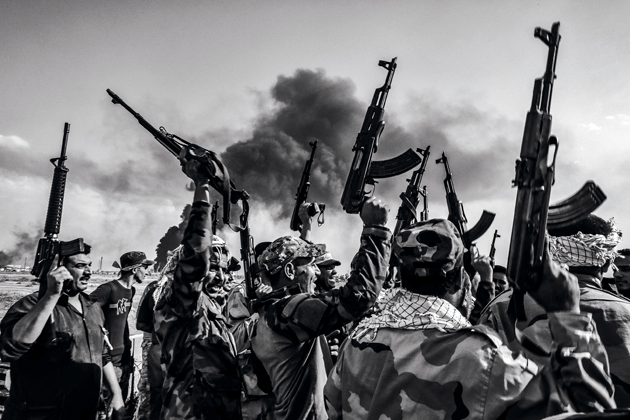
Hashd al-Shaabi militia members after taking control of oil fields that were hit by a U.S. air strike and seized from the Islamic State, Baiji
The revolution was over. We saw Barzani and his men pack their radios, maps, supplies, and documents into jeeps and head north, away from the Iraqi Army. We fled with them just as Saddam’s helicopters unleashed their fury on Salahuddin. Barzani still calls us and the other journalists who covered that rebellion the Class of ’91. In 2003, McCullin and I came back to Iraq to cover another war. Barzani seemed more confident then. His forces, along with the P.U.K.’s, drove into Kirkuk and Mosul under American air cover and accepted the surrender of Saddam’s defeated officers.
Eleven years later, in August 2014, the Kurds nearly lost Erbil again, this time to the rapidly advancing Islamic State. That summer, however, the Kurds did not run, as they had when Saddam’s legions swept into their areas. They had less to fear and more to defend: the autonomous Kurdish state itself, however corrupt and inefficient, and all that they had built since 1991 — the schools, hospitals, universities, institutions for women’s rights, new houses and apartment buildings, businesses, factories, and community centers. When American air support finally arrived after much delay, the Kurds protected their core areas and slowly regained other territory. This is a war of survival: the Kurds’ secular republic cannot coexist with the Islamic State’s Salafi tyranny.
When we visited Barzani this fall, in a stately and impressive new presidential palace on the grounds of his old estate at Salahuddin, he recalled our previous visits. “We wished that the conflict of 1991 had been the last one,” he said. “Also I wish that the toppling of the regime in 2003 had been the last one.” Barzani’s second term as K.R.G. president expired last August, but he postponed new elections on the grounds that his forces first had to defeat the Islamic State. The K.R.G. judicial council extended his term for two years. Many voices have criticized his leadership for tolerating corruption, for incompetence that has crippled the economy, and for nepotism. A friend of mine whose family has been at the forefront of Kurdish political life almost as long as the Barzanis complained, “My president is a Barzani. My prime minister is called Barzani. The chief of security is a Barzani. And they call this a democracy?” But Barzani has also helped bring Kurdistan into the twenty-first century. Erbil was a dusty backwater in 1991. Now it has gleaming, featureless skyscrapers, shopping malls, a first-class international airport, and American fast-food outlets, all of which make it look, for good or ill, like Dubai. Other Kurdish towns have also prospered; few bear much resemblance to what I saw twenty-five years ago. Yet the people have not had time to benefit from a stable peace, and the peshmerga are ill equipped to guarantee long-term security.
McCullin and I told Barzani about our tour of the front lines and his commanders’ complaints about the lack of weaponry. Why didn’t they have what they needed? “I want you to ask this question of the international community,” Barzani said. “Despite all the praise they have for the peshmerga forces and the fact that we are fighting on behalf of the free world against this enemy, the level of support is not up to the level of the war.” He said that he had no choice but to rely on American support and supervision. But why, then, didn’t he coordinate his strategy with Baghdad, hitting the Islamic State in the north at the same time the Hashd al-Shaabi attacked them in the south? After all, Winston Churchill, no friend of Communism, cooperated with Stalin against the Nazis. This brought a laugh. “Do you think the relationship between us and Baghdad is like the relationship between Stalin and Churchill?”
A few days later, McCullin and I traveled to the southern front of the war against the Islamic State, about eighty kilometers north of Baghdad. We explored several frontline positions, as we had in Kurdish territory. The Shiite militias, unlike the Kurds, were not digging in. They were lined up along highways and canals, exchanging artillery fire with the Islamic State. There was more destruction from ground combat and air strikes. We saw the detritus of battle everywhere. At the forlorn and deserted town of Balad, concrete buildings had collapsed, and steel rods were twisted into spiderwebs.
Shiite commanders at a forward operating base near Ramadi told us that Islamic State forces were only a mile away. There were the occasional sounds of mortar or artillery rounds, some going out and others landing on our side of the line. There were no fortified barriers like the ones we saw in Kurdistan, and the troops did not complain of weapons shortages. They had all they needed from Iran and Baghdad, including heavy artillery and night-vision goggles. If the Islamic State avoided using its suicide trucks here, it was perhaps because the Hashd al-Shaabi could hit them with armor-piercing rockets. We saw the same thing all along the front, hundreds of volunteers ready to advance. They were well armed and undisciplined. A few came forward to tell us they were Sunni, but the overwhelming majority were Shia.
While we were in Baghdad, a Russian military delegation arrived in the city to confer with Iraq’s Ministry of Defense. A taxi driver taking us through Baghdad’s clogged streets insisted, unprompted, that the United States had created the Islamic State. He accused the Americans of airdropping supplies to the group, which he claimed to have seen with his own eyes. “Russia is good,” he said, “Not like America.” An adviser to Haider al-Abadi, Iraq’s prime minister, who asked me not to print his name, said that the only way to get rid of the Islamic State was “to put pressure on the Saudis, Qatar, and the Turks.” He favored a coalition of the United States, Russia, Iran, Iraq, and Hezbollah to defeat the group. “We are paying with the lives of our young men,” he said, implying that this was not the time to be fastidious about alliances.
America’s options are few, mainly because of the restraints it puts on itself. The United States seems unable or unwilling to persuade Turkey to close its border with the Islamic State. It has not prevented Saudi Arabia from sending weapons to jihadi groups in Syria. America’s regional allies have surrounded it with red lines. Turkey does not want it to coordinate with Turkish Kurds, wherever they are fighting. Israel and Saudi Arabia forbid coordination with Hezbollah and Iran. Turkey and Saudi Arabia would be outraged if the United States cooperated with the regime in Syria. Yet Iran, the Syrian army, Hezbollah, and the Kurdish factions are the only forces fighting the infantry battles that must be won to vanquish the Islamic State. No one in Iraq believes that air power on its own can do the job. Every army is waging a separate war that allows the Islamic State to fight one opponent at a time.
The Islamic State’s success recalls the Muslim conquests of the seventh century — a comparison that the leaders of the so-called caliphate in Iraq and Syria would undoubtedly welcome. The holy warriors swept through the Arabian Peninsula and into the Fertile Crescent, defeating the Byzantine and Persian Empires. The Byzantines and Persians, filled with fantasies of their own power, did not put aside their differences to meet the common enemy. Both were defeated.

